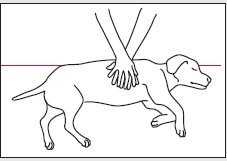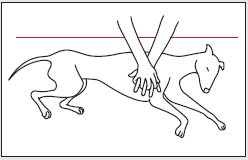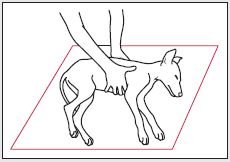
Even the most loving dog owner probably wouldn’t list mouth-to-snout as the preferred way of expressing affection for his pet. But what if it could save the life of a companion animal who has stopped breathing?
A yellow Lab was frolicking in the Gulf waters off the coast of Tampa, Florida, this past summer when she started struggling and her owners swam out to save her. They succeeded in getting her back to shore, but by that point her breathing had given out. She had gone into cardiopulmonary arrest, more commonly referred to as cardiac arrest.
Someone immediately started performing CPR (cardiopulmonary resuscitation), a combination of chest compressions and breathing into the dog’s nose, and after some suspenseful moments the dog finally came to, standing shakily as cheers rose from a greatly relieved crowd who had gathered on the beach.
Easy peasy, right? No, not really. First, there’s the fact that doing CPR correctly (and this is true for people as well as dogs) is physically taxing, exhausting, even. In fact, says one veterinary cardiologist we spoke with, “the general rule of thumb for most people is that if you are doing good chest compressions, you will need to take a break after two minutes of working on a medium or large dog because you will simply be too tired to keep going and maintain effective compressions.” That is, CPR is a real workout.
Then there’s the fact that when you search for how to do it on the Internet, different reputable organizations offer differing sets of instructions. For instance, one site we looked at said to start by breathing into the dog’s nose, while another said to start with the chest compressions. Sites also differ on whether a dog should be on her back or her side. There are differences of opinion, too, on how quickly the compressions should go. For instance, one site says to perform the compressions at a rate of 60 per minute for a dog over 60 pounds, while a second one says that the rate should not fall below a rate of 100 compressions per minute. How are you supposed to prepare yourself given the inconsistencies in instructions for how to do CPR correctly?
The best instructions to go with
We suggest going with the recommendations of a group of emergency and critical care specialists and other researchers from multiple veterinary schools across the globe, including Tufts, who led an initiative called RECOVER: the Reassessment Campaign on Veterinary Resuscitation. The scientists developed a set of guidelines for giving CPR to dogs (and cats) based on actual evidence of what works according to the scientific literature on the subject. And they published it in the Journal of Veterinary Emergency and Critical Care, a prestigious research journal that will not accept papers unless and until they have been thoroughly vetted and deemed up to snuff by fellow scientists in the field.
“The development of specific, evidence-based guidelines for human CPR…has allowed consistent training for…the lay public, leading directly to improved outcomes,” the researchers write in that paper. “No comparable evidence-based guidelines have been available in veterinary medicine….The absence of standardized, comprehensive training coupled with a lack of consensus…has led to significant variability in the approach to veterinary CPR, likely to the detriment of our patients.” Their work to scour the literature and develop guidelines through consensus on how CPR works best in dogs (and cats) responds to that gap.
What follows is a synopsis of the guidelines that dog owners can work with either on their own or other people’s pets. Bear in mind as you read that many dogs faint/lose consciousness for 10 to 20 seconds or so for reasons having nothing to do with cardiac arrest, and the majority of them will get up on their own without CPR.
Also important to keep in mind is that sometimes an owner gets bitten in the process. They for sure need to make certain the animal is non-responsive with no heartbeat and no respiration for more than 15 seconds before doing any mouth-to-snout breathing.
Finally, happy stories of dogs “coming back from death” notwithstanding, the success rate of CPR is quite low. For dogs on whom CPR is performed by veterinary healthcare professionals right in the hospital, some 35 to 45 percent will start breathing again, according to the RECOVER report. But the rate of survival to hospital discharge falls along the lines of 2 to 10 percent. Dogs who need CPR are often pretty sick. Numbers don’t exist for dogs on whom CPR is performed outside a hospital setting, but one can assume the odds for survival in such cases is even lower.
That doesn’t mean you shouldn’t become acquainted with the proper procedure for performing CPR in the highly unlikely event that it may prove necessary; it’s good to have this potentially life-saving tool in your arsenal. You just want to manage your expectations.
4 steps for CPR
Step 1. Dog position and hand placement. Dogs both large and small should be placed on their side rather than their back. It doesn’t matter if they are put on their left side or their right. The only exception to this might be a barrel-chested dog like an English bulldog. The researchers believe blood might be pumped through the heart and lungs at least as well with a bulldog lying on its back as on its side.
While the position of the dog generally does not differ whether it is a Chihuahua or a Great Dane, the position of the person’s hands on the dog’s chest does. For medium, large, and giant breed dogs (essentially meaning dogs who weigh more than 20 pounds), the best place is over the widest portion of the chest, one hand on top of the other.
The exception here is keel-chested (narrow, deep-chested) dogs such as greyhounds and also barrel-chested breeds. In dogs with either of those body conformations, positioning the hands directly over the heart is a reasonable way to go. It all has to do with how to achieve the best pressure with the compressions to move blood through the cardiopulmonary (heart-lung) system.
Small dogs (as well as cats) need a different hand placement still. For them, one hand — wide enough to pretty much wrap around the animal’s chest — will work, with the person’s fingers placed around the sternum (breastbone) at the level of the heart. Compressions done from this position are called circumferential compressions because they involve the hand going around much of the dog’s circumference.
The researchers note that if the person doing the compressions becomes fatigued or the dog’s chest doesn’t bounce back easily after being compressed because of, say, obesity or old age, the same placement of hands on the chest can be used on small dogs as on medium and larger dogs.
Step 2. The compressions. Getting the compressions right is probably the trickiest part of CPR. The evidence is strong that the odds of a dog’s coming to and surviving 24 hours later are stronger if the compression rate is 100 to 120 pushes a minute. There is even some evidence, the RECOVER scientists say, that higher compression rates of up to 150 pushes a minute may be even more advantageous. But it might be very hard to do good, functional chest compressions at 120 compressions a minute. A hundred well-performed compressions a minute is probably more in the ballpark of what people can achieve, and is likely to work if CPR is going to work at all. How fast is 100 compressions a minute? One anecdotal recommendation is to sing “Stayin’ Alive” and go with the rhythm of the song.
The compressions themselves should be deep, with the hands (or hand) pressing the chest down to a depth that equals one third to one half the width of the thorax (essentially the chest cavity). Of course, you’re not going to have a tape measure with you, but this means you really have to push down hard, and you have to do it in rapid succession to reach a rate of 100 beats a minute. To add to the time constraints, the chest should come fully back up between chest compressions; you should not push down again until there has been what scientists call “full elastic recoil.” If you do, you’re not perfusing blood through the circulatory system as best as possible, so the dog has less chance of coming to.
Another way of putting all this: performing compressions is not for the faint of strength or coordination.
Step 3. Ventilation (Mouth-to-Snout). The proof that mouth-to-snout ventilation helps dogs regain consciousness during CPR is actually scant to nil. That doesn’t mean you shouldn’t try it. It’s just that what research has shown so far is that good compressions offer the lion’s share of promise.
The right way to give breaths is for the rescuer to hold the dog’s mouth tightly closed and place his or her mouth over the animal’s nostrils to make a seal with the snout, then blow into the nostrils.
What’s the right sequence for compressions and mouth-to-snout? The evidence to date suggests starting with 30 compressions followed by two breaths. That means that if you’re performing chest compressions at a rate of 100 per minute, you should do them for just under 20 seconds (20 seconds — a third of a minute — would come to 33 compressions), then briefly stop to deliver the two breaths. As little time as possible should be lost between breaths and the next set of compressions; it’s okay to have one person doing the compressions while another delivers the breaths.
After two minutes of compressing and then breathing, someone else should take over performing the compressions. As we have noted, compressions are very fatiguing, and the quality of the compressions is likely to become compromised after that time.
Step 4. Get the dog to the hospital. If after about five two-minute cycles the dog does not come through, the odds are very low that she will. If she does come to, stop the CPR as soon as she takes a breath on her own. Not only does she not need any more help respirating, you also don’t want a situation where you’re right up against her face and the disorientation of coming back to consciousness might lead her to react in an aggressive way.
Conscious or not, get her to the hospital immediately. A veterinary facility has machinery and medications you don’t that will facilitate treatment of cardiac arrest, giving her a better chance of long-term survival. Consider, too, that whatever caused the cardiopulmonary arrest might not be fixed yet, meaning it needs to be tended to so it doesn’t happen again. There can also be compromised function of various organs throughout the body, brain injuries, and damage to other tissues. And the CPR itself can cause problems like broken ribs that need to be treated. Complications like these are believed to contribute to the high rate of mortality even when an animal is “brought back,” but if the dog is being watched and treated by medical professionals, the odds that she will return to full health rather than succumb improve significantly.
ProperPlacement of Dog and Hands for the Best Chest Compressions









